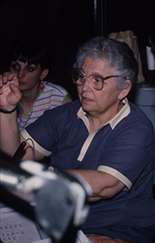Sonia Landy Sheridan
| Sonia Landy Sheridan | |
|---|---|
 Sonia Sheridan at her studio in Chicago | |
| Born |
10 April 1925 Newark, Ohio |
| Nationality | American |
| Education |
Hunter College BA 1945 Columbia University California College of Arts and Crafts MFA 1960 |
| Known for | Generative Systems |
| Spouse(s) | James Edward Sheridan (d 2015) |
| Website | http://www.artic.edu/aic/collections/artwork/59339?search_no=1&index=3 |
Sonia Landy Sheridan (born April 10, 1925), is an American artist and academic, who in 1970 founded the Generative Systems research program . Professor emeritus at the School of the Art Institute of Chicago (SAIC), and she is honorary editor of Leonardo, the Journal of the International Society for the Arts Sciences and Technology (Leonardo/ISAST).[1][2] She received as an artist grants from numerous institutions, including "The Guggenheim Foundation" (1973-1974) and the National Endowment for the Arts (1974-1975, 1976-1977, 1981-1982).[3]
Biography
Sonia Landy Sheridan was born on April 10, 1925, in Newark, Ohio. She majored in French and the visual arts at Hunter College in New York City between 1941 and 1945. Between 1946 and 1947, she attended at Columbia University in New York city for an MA in French and Russian and, between 1948 and 1949 she did graduate studies at the University of Illinois, Chicago, USA.[3]
In 1957, she moved with her husband, James E. Sheridan, to Taiwan and, during their stay, she attended the National Taiwan Normal University. In 1961, back in the United States, she was an instructor at the California College of Arts and Crafts where she received her MFA in 1960.[3]
In the 1960s, she began to teach at the School of the Art Institute of Chicago, where she founded in 1970 a new department called Generative Systems, which was a program dedicated to studying, through hands on practice, the evolution of Art Systems triggered by a rapidly changing Technology in Society. She and the students worked with Industry, scientists and other scholars. The earliest investigation of artistic use of new technologies emerging in that period, for example the world's first color photocopier, the 3M Color in Color Machine.[4] In the meantime, she continued with her artwork, and in 1974 she exhibited at the MoMA of New York together with Keith Smith.[5][6]

Her artistic works were shown in many different institutions, the most relevant in 1969 at the exhibition the "Software Show" at the Jewis Museum in New York, where they did a historic catalogue. For the first time in Europe, within the collective exhibition Electra, made in the year 1983, at the Musée d'Art Moderne de la Ville de Paris.[7] In this exhibition she presented the first image manipulation software for artists, Lumena artware of TimeArts.[8] Three years later, her work was shown for the first time in Spain, together with other artists such as Nam June Paik, Marisa Gonzalez, Paloma Navares, Marina Abramovic, John Cage... at the inaugural collective exhibitions of the Museo Nacional Centro de Arte Reina Sofía of Madrid titled "Procesos: Cultura y nuevas tecnologías", which offered a compilation of different artistic approximations by the use of the new means that arose in the contemporary art during the second half of the 20th century, and in which she presented, apart of her work, the graphic computer invented by her student of SAIC, John Dunn, the EASEL software and Time Arts PC computer. With this system, during a month, she made a workshop open to all the public at the exhibitions rooms of the Museo Reina Sofía.[9][10]
Sonia Sheridan had her last solo show "The Art of Sonia Landy Sheridan" exhibition opening in October, 2009 at The Hood Museum of Art in Dartmouth College, Hanover (New Hampshire).
In 2013 at the Festival of Art and Visual Culture in Berlin, Transmediale, the curator of the exhibition of the festival, Jacobo Lillemose, selected Sonia Sheridan with her solo show "Exhibition Imaging with Machine Processes". The Generative Art of Sonia Landy Sheridan as a researcher and pioneer in new media not only in North America but throughout the world, as well as for her teaching at SAIC, the School of the Art Institute of Chicago.
Her work forms part of big collections like The National Gallery of Canada (Ottawa, Ontario), Museum of Science & Industry (Chicago, IL, United States), University of Iowa Museum (Iowa City, IA, United States), Visual Studies Workshop (Rochester, NY, United States), Brooklyn Museum (Brooklyn, NY, United States), Intercommunication Center (Tokyo, Japan), and 3M Corporation (Saint-Paul, MN, United States) at The Hood Museum of Art Dartmouth College (Hanover, NH, United States), this museum acquired 684 tworks produce by Sheridan between the year 1949 y 2002.[3]
The Hood Museum of Art (Hanover, New Hampshire), and all the documentation on her long artistic career can be consulted in the Foundation Daniel Langlois of Montreal.[11][12][13]
Her biographer is the Art Historian Diane KirPatrick.
Publications
- Art at the Dawning of the Electronic Era. Generative Systems. (Lonesome Press, Hanover, 2014)
- Generative Systems in La Fabrica: Marisa Gonzalez. (Foundation Telefónica, Madrid, 2000)
- Energized Art/Science. (Chicago Museum of Science and Industry and 3M Corporation, St. Paul, 1978)
- Artist in the Science Lab. (3M Corporation, St. Paul, 1976)
- Evolution 2.0. Generative Systems & Generative Art. (ISEA, Liverpool, 1998)
References
- ↑ The Art Institute of Chicago
- ↑ Leonardo
- 1 2 3 4 "Sonia Sheridan : Biography". www.fondation-langlois.org. Retrieved 2017-12-12.
- ↑ «Imaging With Machine Processes | transmediale».
- ↑ «MoMA | Projects».
- ↑ "Proto punk and generative art pioneer-Sonia Landy Sheridan - Mad Art Lab". Mad Art Lab. 2016-05-10. Retrieved 2018-01-29.
- ↑ www.fondation-langlois.org.
- ↑ «Sonia Sheridan fonds
- ↑ Consulted the 2016-01-22.
- ↑ www.museoreinasofia.es.
- ↑ «Artistic Collections».
- ↑ «Sonia Sheridan fonds
- ↑ «The Art of Sonia Landy Sheridan | Hood Museum».